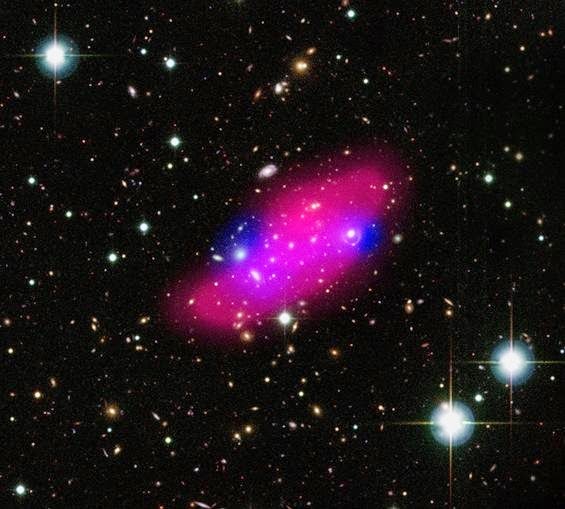| Online: | |
| Visits: | |
| Stories: |

| Story Views | |
| Now: | |
| Last Hour: | |
| Last 24 Hours: | |
| Total: | |
Black Holes and the Dark Sector Explained by Quantum Gravity
Ask any theoretical physicist on what are the most profound mysteries in physics and you will be surprised if she mentions anything other than Quantum Gravity and the Dark Sector. Questions such as how do we reconcile GR and Quantum Theory? What is Dark Matter? And what is Dark Energy? These are what keep most physicists awake late at night. Suggested solutions to these problems are manifold but all fall short of providing a satisfactory explanation.
This is a composite image of the Bullet Group showing galaxies, hot gas (shown in pink) and dark matter (indicated in blue).

Credit: ESA / XMM-Newton / F. Gastaldello (INAF/IASF, Milano, Italy) / CFHTLS.
The theory is known as Nexus in the sense that it provides a link between Quantum Theory and GR. This link manifests in the form of the Nexus graviton- a composite spin 2 particle of space-time which emerges naturally from the unification process. One remarkable feature of the Nexus graviton which distinguishes it from the graviton hypothesized in the Standard Model is that it is not a messenger particle but rather it induces a constant rotational motion on any test particle embedded within its confines.
This paper is significant in the sense that it sheds some light on some of the most perplexing questions in physics which include a quantum description of Black Holes without singularities inherent in classical GR.The solutions provided in this paper will certainly open doors to new physics.
Source: http://www.ineffableisland.com/2015/03/black-holes-and-dark-sector-explained.html





More magical thinking and belief in miracles in a science fiction mix from Lic. Stuart Marongwe, who is a little late to the table. Gravity and dark matter and energy in the vacuum have been elucidated in detail in many research reports in the Journal of Binary Mechanics starting some five years ago.